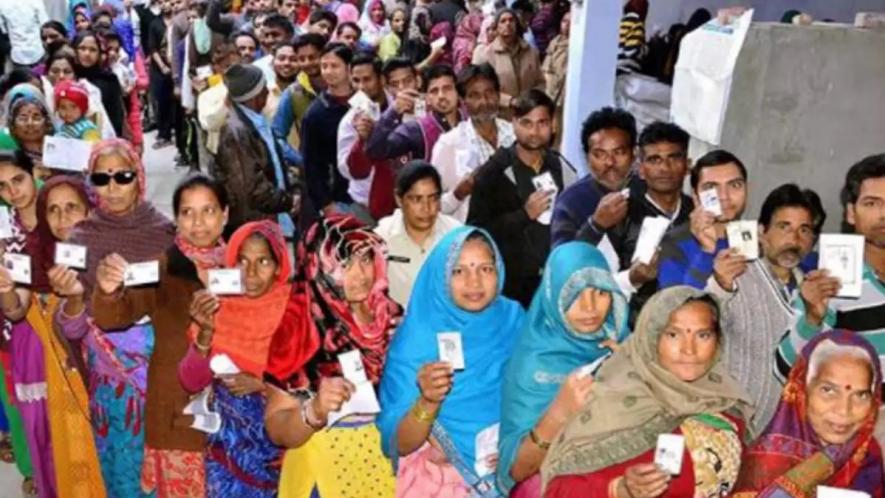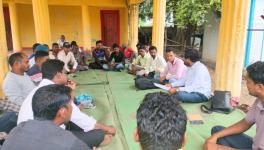Massive Surge in Voter Turnout in 10 Reserved Seats of MP May Benefit Congress, Say experts

Representational image. | Image Courtesy: The Hindu
Bhopal: The reserved seats of Madhya Pradesh have recorded whopping 10% to 16.3% surge in voting turn out, according to the Election Commission of India (ECI).
The state has 29 parliamentary seats, of which, 10 seats are reserved for Schedule Castes and Schedule Tribes. The SC/STs comprise 36.61% of the state population (SC 15.51%, ST 21.1%), according to 2011 Census.
Out of these 10 seats, Shahdol, Mandala, Betul, Ratlam, Dhar, and Khargone are reserved for STs, while Tikamgarh, Bhind, Dewas and Ujjain are reserved for SCs.
Tikamgarh has recorded the highest surge of 16.33%, while Dewas recorded the shortest jump of 8.76% in voter turnout when compared with the last general election. Overall, the surge has been 11.15% as per the ECI data.
| Seats | 2014 | 2019 | Surge in % |
|---|---|---|---|
| Shahdol | 62.02% | 74.58% | 12.38 |
| Mandala | 66.71% | 77.62% | 10.91 |
| Tikamgarh | 50.15% | 66.48% | 16.33 |
| Betul | 66.48% | 78.20% | 11.72 |
| Bhind | 45.63% | 54.49% | 08.86 |
| Dewas | 70.72% | 79.48% | 08.76 |
| Ujjain | 66.56% | 75.33% | 08.77 |
| Ratlam | 63.52% | 74.46% | 11.94 |
| Dhar | 63.96% | 75.19% | 11.23 |
| Khargone | 67.07% | 77.69% | 10.62 |
Congress President Rahul Gandhi had addressed rallies in eight of these 10 constituencies, while Prime Minister Narendra Modi had conducted rallies in four.
The Bharatiya Janata Party (BJP) has dominated the tribal region for the last three decades. In the 2014 general elections, the BJP had won all reserved seats, but lost Ratlam in 2015 byelection to Congress. In recently concluded Assembly elections, however, the Congress fared far better than the BJP in the reserved seats.
The reason of high turnout
Addressing a press meet after the last phase of polling, state Chief Electoral Officer V L Kantha Rao said, “We are not on top as far as overall voting percentage is concerned, as there are states like West Bengal where 80% voting is normal. But we have been on top in all the four phases as far as increase in voter turnout is concerned. In the 7th phase in Malwa-Nimar region, the voting percentage went beyond 75 per cent. Besides, we have recorded massive surge in reserved seats, which is quite astonishing.”
When asked about the reason behind this massive jump, he said, “Though we have performed better in overall seats, but as far as reserved seats are concerned, hyper local and regional content in campaigning, doorstep delivery of voters’ slip, proximity to the polling booths, and fair and fearless environment are the major reasons behind the high jump in the voting percentage.”
But the political parties and experts think differently.
The Congress claimed that high turnout is evident of the anger of the voters towards the current regime and local leaders, and they have shown trust in Rahul Gandhi and Congress, while the BJP believed in strong Modi wave.
Senior journalist Ashutosh Shukla believes that the rise of two political outfits in the last couple of years in Madhya Pradesh – Gondwana Gantantra Party (GGP) and Jai Adivasi Yuva Sangathan (JAYS) – in different pockets of the state has crated political awareness among the tribal voters, and it is one of the major reasons of high voting percentage.
"Both the parties fight for the rights of the tribals and Dalits, and they have huge influence over tribal and SC voters," said Shukla.
GGP has influence over Shahdol, Mandala, Balaghat, Chhindwara, Sidhi and Betul parliamentary seats, which share border with Chhattisgarh, Maharashtra and Uttar Pradesh. JAYS, on the other hand, is playing a key role in the seats of Malwa-Nimar region such as Dewas, Ratlam, Dhar, Khargone and Khandwa, bordering Gujarat, Maharashtra, and Rajasthan. JAYS has also tilted towards the Congress, and has supported the grand old party in both Assembly and general elections.
“The reserved seat votes have been slipping from the BJP and tilting towards Congress. The reasons are numerous,” claimed GGP leader Gulzar Sing Markam.
Referring to the Supreme Court’s recent order on the Forest Righs Act and jump in Dalit atrocities, Markam said, “The BJP has developed an image of a pro-businessmen, anti-tribal and anti-Dalit party, which wants to hand over forests to businessmen; the recent SC order proves it. Besides, the atrocities against dalits have increased in Modi’s regime and instead of acting, the government has turned a blind eye to them and is protecting the culprits.”
Backing Markam’s claim, Shukla said, "The SC's decision have left significant impact on BJP's tribal vote bank and tribals have started seeing the BJP as anti-tribal party. Evidently, this has benefited the Congress."
For the last two decades, the Gond tribe has been demanding the inclusion of Gondi language in primary schools, hence, soon after coming to power, the Madhya Pradesh Chief Minister had announced the inclusion of Gondi language in primary schools. The move is also likely to cause Gond and Baiga tribals to tilt towards Congress.
Recently, tribal voters of Madhya Pradesh held a massive rally in Burhanpur district of the state demanding to uphold the Forest Rights Act 2006 (FRA) and withdrawal of the proposed amendment to the Indian Forests Act 1927 by the BJP-led National Democratic Alliance (NDA) government.
Also read: Elections 2019: Are Tribal Votes Slipping from BJP in Madhya Pradesh?
A political analyst, Jairam Shukla, told NewsClick, “Earlier, it was generally assumed that increase in voting means more votes against the incumbent government and less voting meant apathy of the voters. But, it’s no longer true. The increase in voting doesn’t necessarily mean that people have voted against Modi or BJP. In fact, it could be the other way round. I believe it is a group of silent voters who have come out to assert their choice. I am pretty sure that BSP, which had a vote share of 17% to 23% in Rewa and Satna seats in Vindhya and Gwalior and Morena of Chambal-Gwalior region, has lost its votes to BJP in a big way.”
“As the BSP leadership is weakening in these pockets, their committed voters too are shifting their votes not to the Congress, but to the BJP. We saw it in the Assembly polls, and would see it again.” he added.
However, senior journalist and author Rasheed Kidwai believes that the massive turnout showed that the people in the state are in a mood to usher in a change.
“Massive turnout always is a sign of change and high voting percentage suggests that the tribal voters want to usher in a change in the region. So, they have voted in large numbers,” said Kidwai.
During 2018 Assembly elections, massive turnout was reported in the Malwa region, a BJP bastion, after numerous farmers’ protests – and the BJP did suffer a major blow there.
The Congress state media vice-president Abhay Gupta opined that voter turnout in the current elections have been high in states including Chhattisgarh, where Congress is in power, especially in reserved seats, while in states like Bihar, where BJP and its allies are in power, voting has been low.
“To me, it’s a clear indication that people have voted for the Congress and party Chief Rahul Gandhi. The party has formed government in Madhya Pradesh, Chhattisgarh and Rajasthan only five months ago,” he said.
Countering Gupta, the BJP chief spokesperson, Deepak Vijayvargiya, said, “There was a strong wave in favour of Narendra Modi in MP. People came out to vote in strength to ensure that results are not like the December 2018 state Assembly elections.”
Get the latest reports & analysis with people's perspective on Protests, movements & deep analytical videos, discussions of the current affairs in your Telegram app. Subscribe to NewsClick's Telegram channel & get Real-Time updates on stories, as they get published on our website.
























